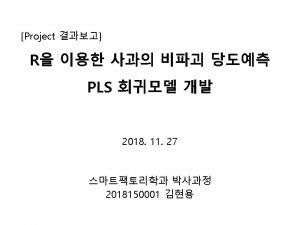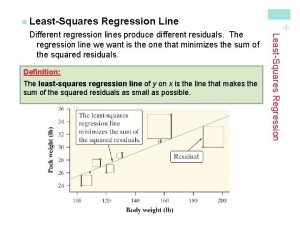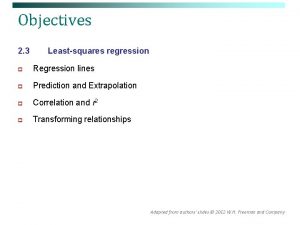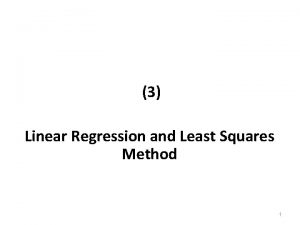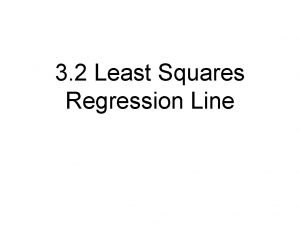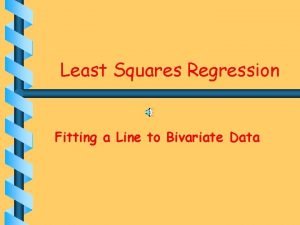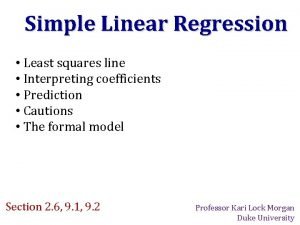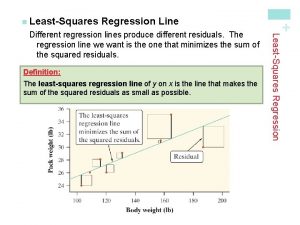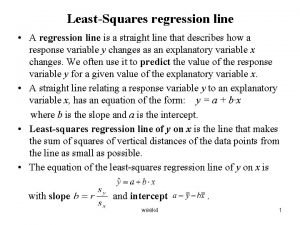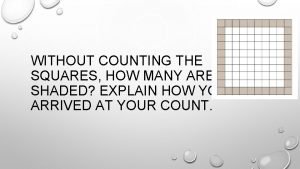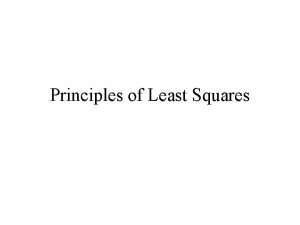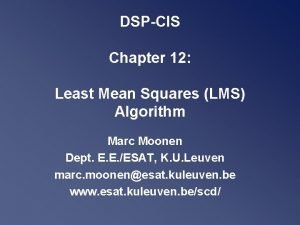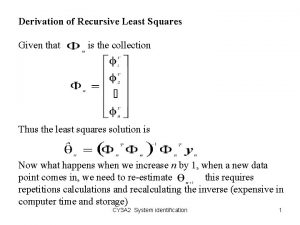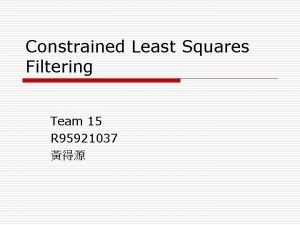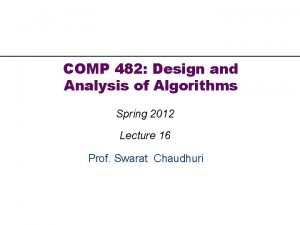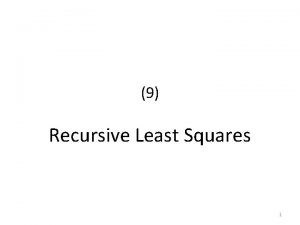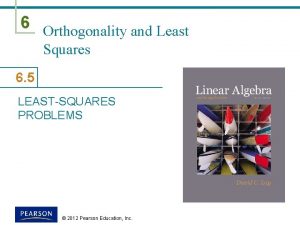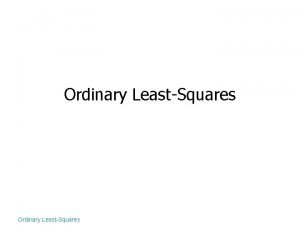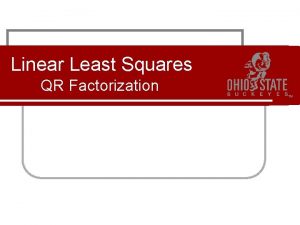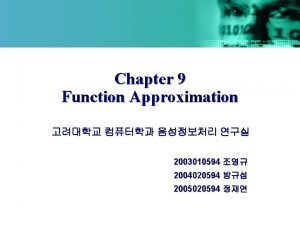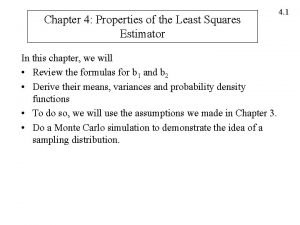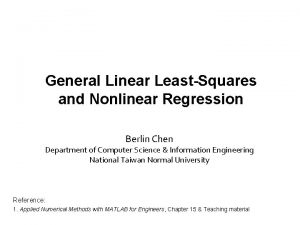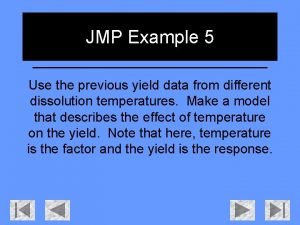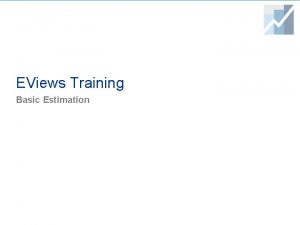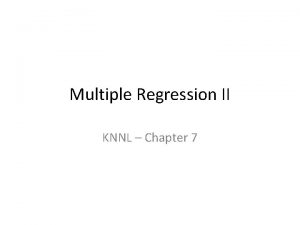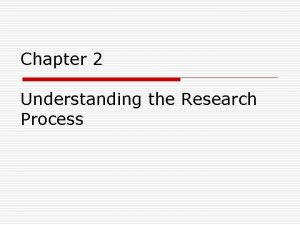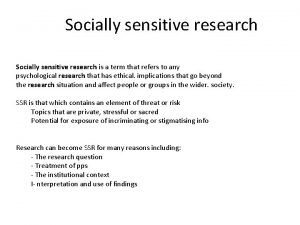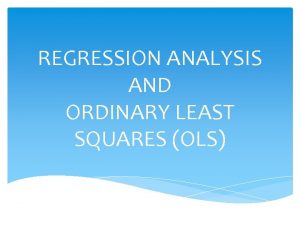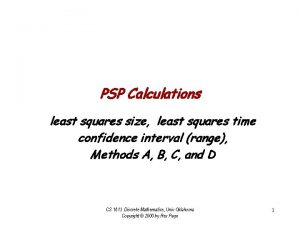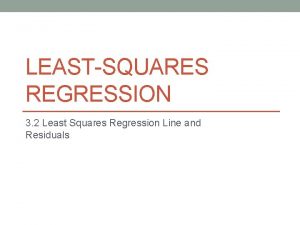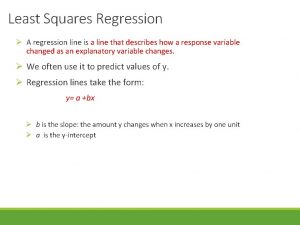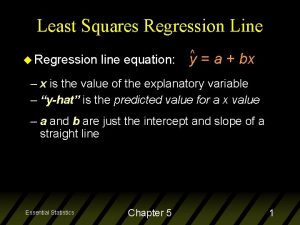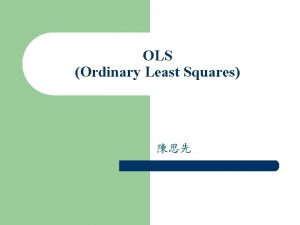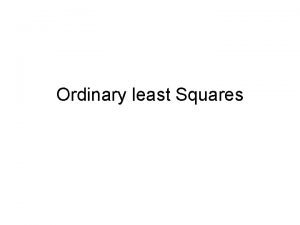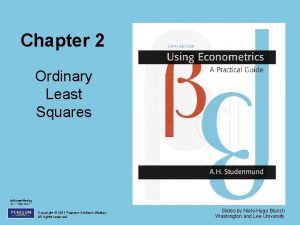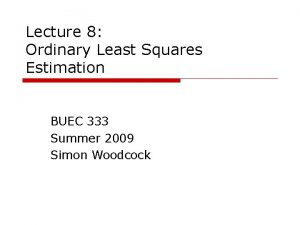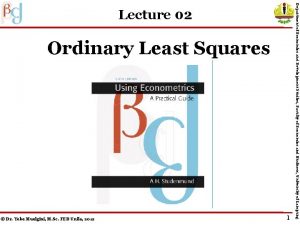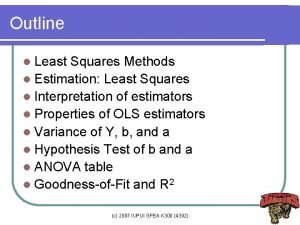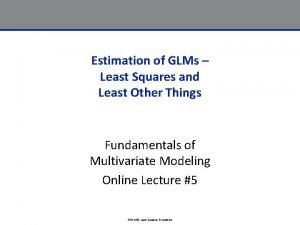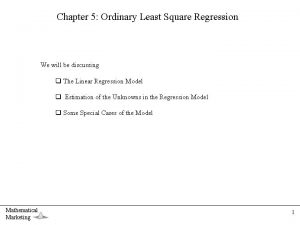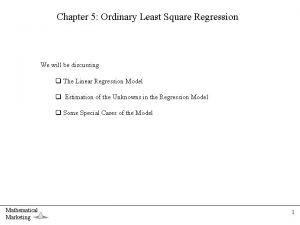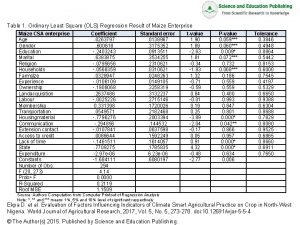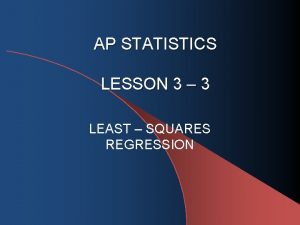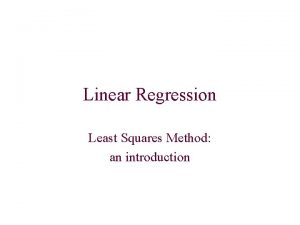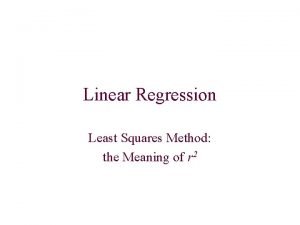Conducting Social Research Ordinary Least Squares Regression Roger








































- Slides: 40

Conducting Social Research Ordinary Least Squares Regression Roger B. Hammer Assistant Professor Department of Sociology Oregon State University

Conducting Social Research Housing Sales Data We have obtained a sample of 40 housing sales that took place somewhere in some year. The data contains two variables, price (in $’s) and size (total above grade finished area in feet 2).

Conducting Social Research Housing Sales Data

Conducting Social Research Housing Sales Data

Conducting Social Research The Ordinary Least Squares (OLS) Model Expected Value Predicted Value Expected Error Estimated Error Notation: No hat on e.

Conducting Social Research Housing Sales Data Bivariate Regression Notation: Using b instead of Beta-hat.

Conducting Social Research Housing Sales Data

Conducting Social Research OLS Characteristics 1) The estimated regression line passes through the means of X and Y. 2) The sum of the residuals is zero. 3) Under specific assumptions, it is the best linear unbiased estimator (blue).

Conducting Social Research Housing Sales Data

Conducting Social Research Click to Open Browser and Go to Regression Residual Demonstration

Conducting Social Research Total Sum of the Squared Deviations Residual Sum of the Squared Deviations Explained Sum of Squared Deviations

Conducting Social Research OLS Minimizes Residual Sum of the Squared Deviations

Conducting Social Research Housing Sales Data

Conducting Social Research OLS selects b 0 and b 1 such that the RSS is as small as possible Notation: Using b instead of Beta-hat.

Conducting Social Research The Coefficient of Determination The proportion of the variance of Y explained by X.

Conducting Social Research Pearson Correlation Coefficient • A standardized measure of the strength of a bivariate relationship. • Theoretically ranges from -1 (perfect negative relationship) to 1 (perfect positive relationship). • Negative – above average values of Y tend to occur with below average values of X and vice-versa. • Positive – above average values of Y tend to occur with above average values of X and vice-versa.

Conducting Social Research The Coefficient of Determination and the Correlation Coefficient • The correlation coefficient represents the bivariate relationship between Y and X. • In bivariate (simple) regression, the coefficient of determination represent the bivariate relationship between Y and X. • In bivariate regression, the coefficient of determination is equal to the squared correlation coefficient.

Conducting Social Research Standardized Regression Coefficients • The unstandardized coefficient of X represents the unit change in Y, resulting from a 1 unit change in X. • The standardized coefficient of X represents the number of standard deviation changes in Y, resulting from a 1 standard deviation change in X. Note: See Standardized Variables in Chapter 16.

Conducting Social Research The Standardized Regression Coefficient and the Correlation Coefficient • The correlation coefficient represents the bivariate relationship between Y and X. • In bivariate (simple) regression, the standardized regression coeffiecient represents the bivariate relationship between Y and X in standard deviation units. • In bivariate regression, the standardized regression coefficient is equal to the correlation coefficient.

Conducting Social Research Housing Sales Data Total Sum of the Squared Deviations

Conducting Social Research Housing Sales Data Sum of Squared Residuals

Conducting Social Research Housing Sales Data Explained Sum of Squared Deviations

Conducting Social Research Housing Sales Data The Coefficient of Determination Goodness of Fit

Conducting Social Research Housing Sales Data Correlation of X and Y

Conducting Social Research Housing Sales Data Correlation of X and Y

Conducting Social Research Housing Sales Data The Coefficient of Determination and the Correlation of X and Y Note: Only holds true in bivariate regression.

Conducting Social Research The Coefficient of 2 Determination, R , is a very bad way to evaluate a model, especially relative to other models.

Conducting Social Research Adjusted R 2 Adjusted for the number of variables in the model degrees of freedom Note: K = Number of Parameters.

Conducting Social Research Simple Regression Model Multiple Regression Model

Conducting Social Research Simple Regression Model Multiple Regression Model

Conducting Social Research Partial Effects • Experiments provide strong evidence about causality since, due to random assignment, X is uncorrelated with other effects on Y. • Regression mathematically adjusts for the correlations of the X’s. • Other relevant variables can only be controlled for if measured and included in the model.

Conducting Social Research Housing Sales Data We have obtained all housing sales for 2005 for Benton County. The data contains a number of variables including sale price, main living area, and garage.

Conducting Social Research Simple Regression Model Multiple Regression Model

Conducting Social Research Partial Coefficient of X 1 Partial Coefficient of X 2

Conducting Social Research Standardized Regression Coefficients • The Y-intercept always equals zero. • All variables are expressed in standardized scores, measured in standard deviations from the mean. • Coefficients indicate by how many standard deviations Y-hat changes, per 1 standard deviation change of X (ceteris paribus).

Conducting Social Research Standardized Regression Coefficients

Conducting Social Research Regression and Correlation Path Analysis – Structural Equation Modeling X 1 . 45673. 502 0. 184 Y X 2 0. 330. 24610 e

Conducting Social Research Standardized Regression Coefficients

Conducting Social Research Structural Equation Modeling X 1 Y 2 X 3 X 4 Y 1 e 2

Conducting Social Research Using Regression Analysis 1) Review the literature and develop theoretical model, including hypotheses. 2) Specify the model including the measurement of the variables and the functional form. 3) Hypothesize the expected signs of the coefficients (if not already done in step 1). 4) Collect, inspect, and clean data (if not already done in step 0). 5) Estimate and evaluate model. 6) Document the results.
 Ordinary least squares
Ordinary least squares Least squares regression line definition
Least squares regression line definition How to find least squares regression line on statcrunch
How to find least squares regression line on statcrunch The least square method
The least square method Least squared regression line
Least squared regression line Polynomial regression least squares
Polynomial regression least squares Bivariate least squares regression
Bivariate least squares regression Least squares regression
Least squares regression Least squares regression line
Least squares regression line Least squares regression line definition
Least squares regression line definition Least squares regression line minitab
Least squares regression line minitab How many squares
How many squares Damien thiesson
Damien thiesson Least square method in surveying
Least square method in surveying Mean ?
Mean ? Recursive least squares python
Recursive least squares python Constrained least square filtering
Constrained least square filtering 4d3d41669541f1bf19acde21e19e43d23ebbd23b
4d3d41669541f1bf19acde21e19e43d23ebbd23b Recursive least squares example
Recursive least squares example Least square solution
Least square solution Least square solution
Least square solution Qr factorization least squares
Qr factorization least squares Approximation de padé
Approximation de padé Estimator of variance
Estimator of variance Regression berlin
Regression berlin Fit least squares jmp
Fit least squares jmp Eviews training
Eviews training Extra sum of squares multiple regression
Extra sum of squares multiple regression Simple multiple linear regression
Simple multiple linear regression Linear model regression
Linear model regression Logistic regression vs linear regression
Logistic regression vs linear regression Logistic regression vs linear regression
Logistic regression vs linear regression Chapter 29 conducting marketing research answers
Chapter 29 conducting marketing research answers Chapter 29 conducting marketing research
Chapter 29 conducting marketing research Limitations of research examples
Limitations of research examples What is socially sensitive research
What is socially sensitive research The marketing research process follows five steps
The marketing research process follows five steps Naturalistic observation def
Naturalistic observation def When conducting research online the keyword
When conducting research online the keyword Conducting marketing research and forecasting demand
Conducting marketing research and forecasting demand Conducting marketing research and forecasting demand
Conducting marketing research and forecasting demand
